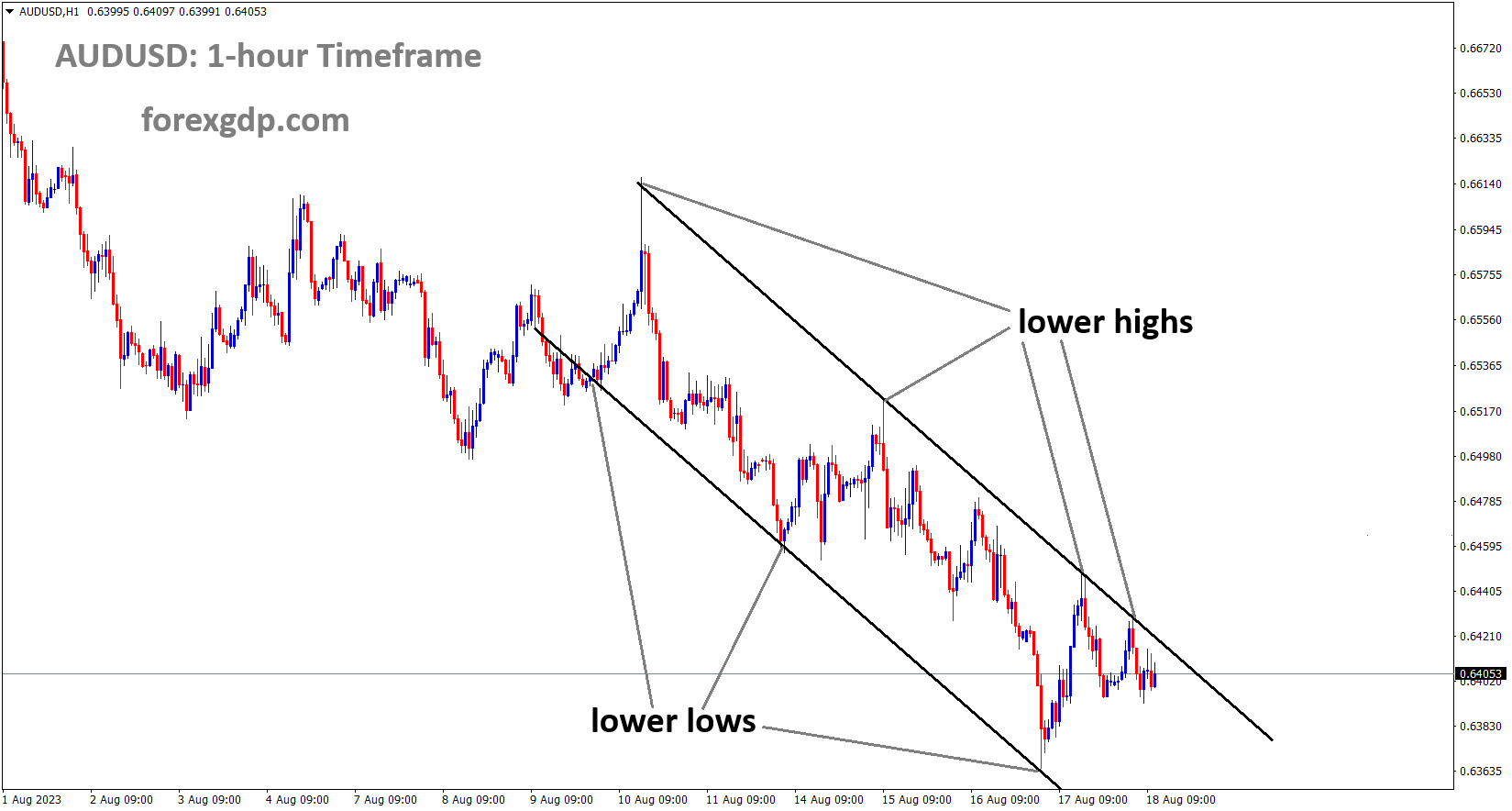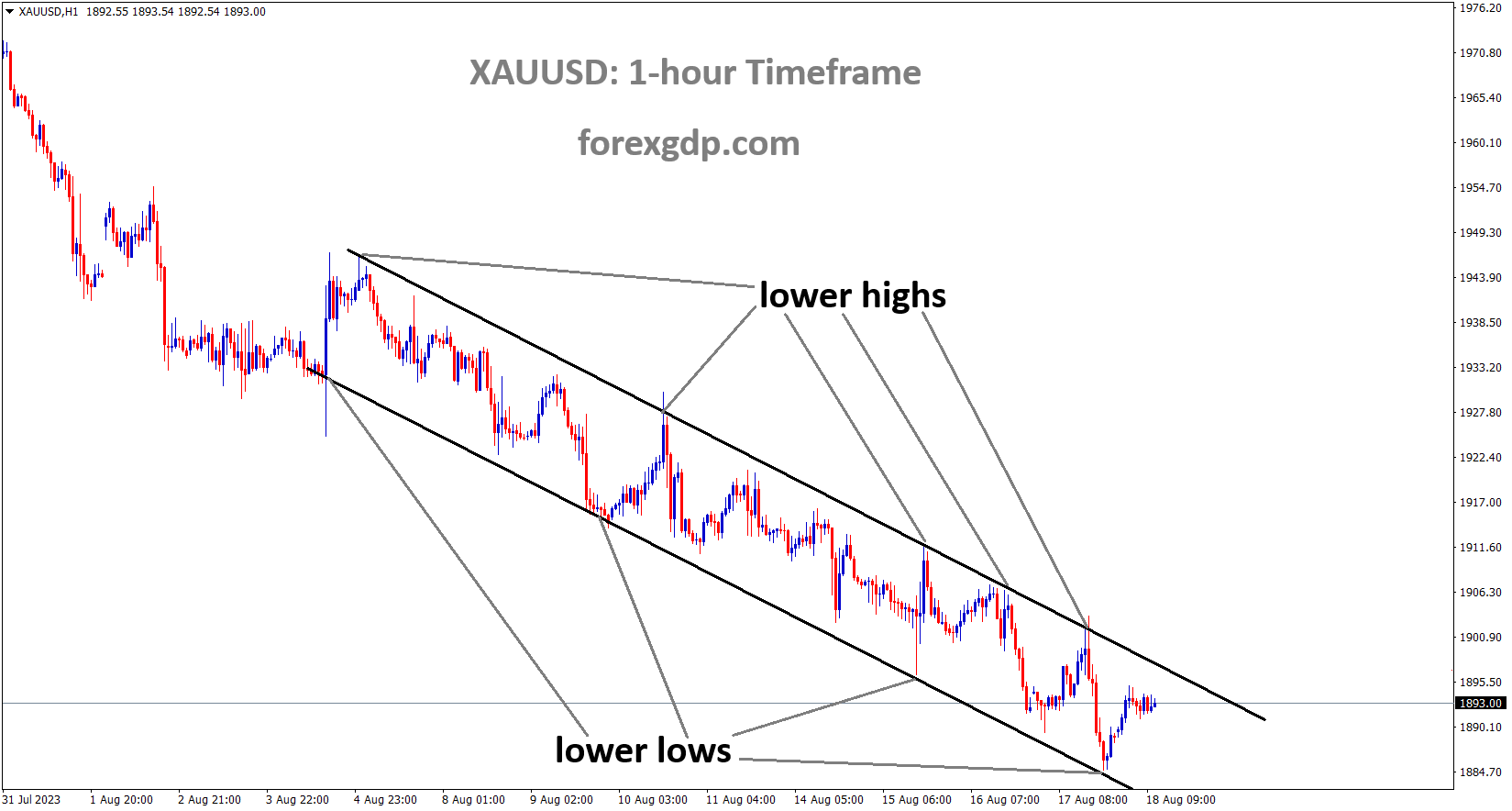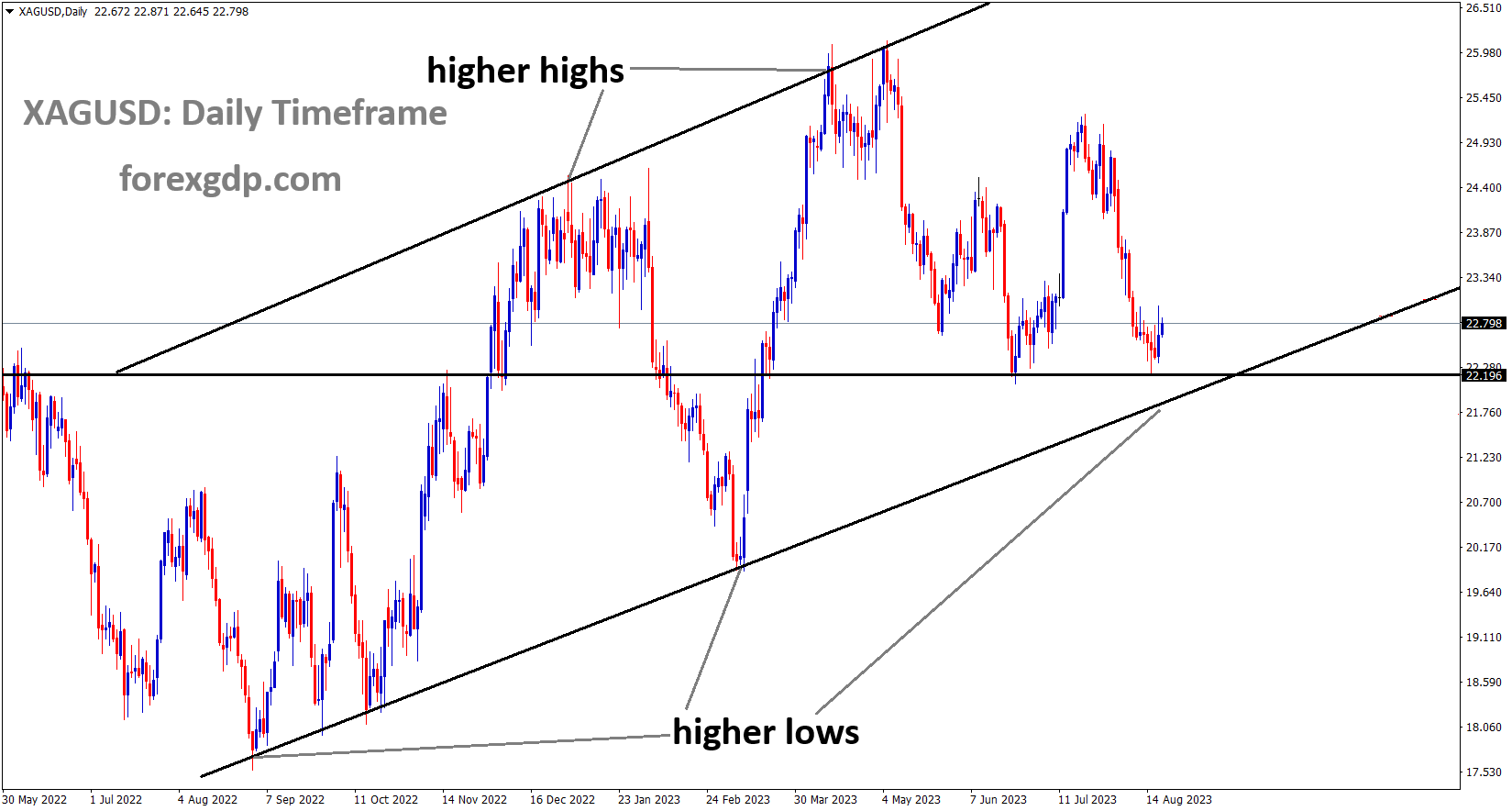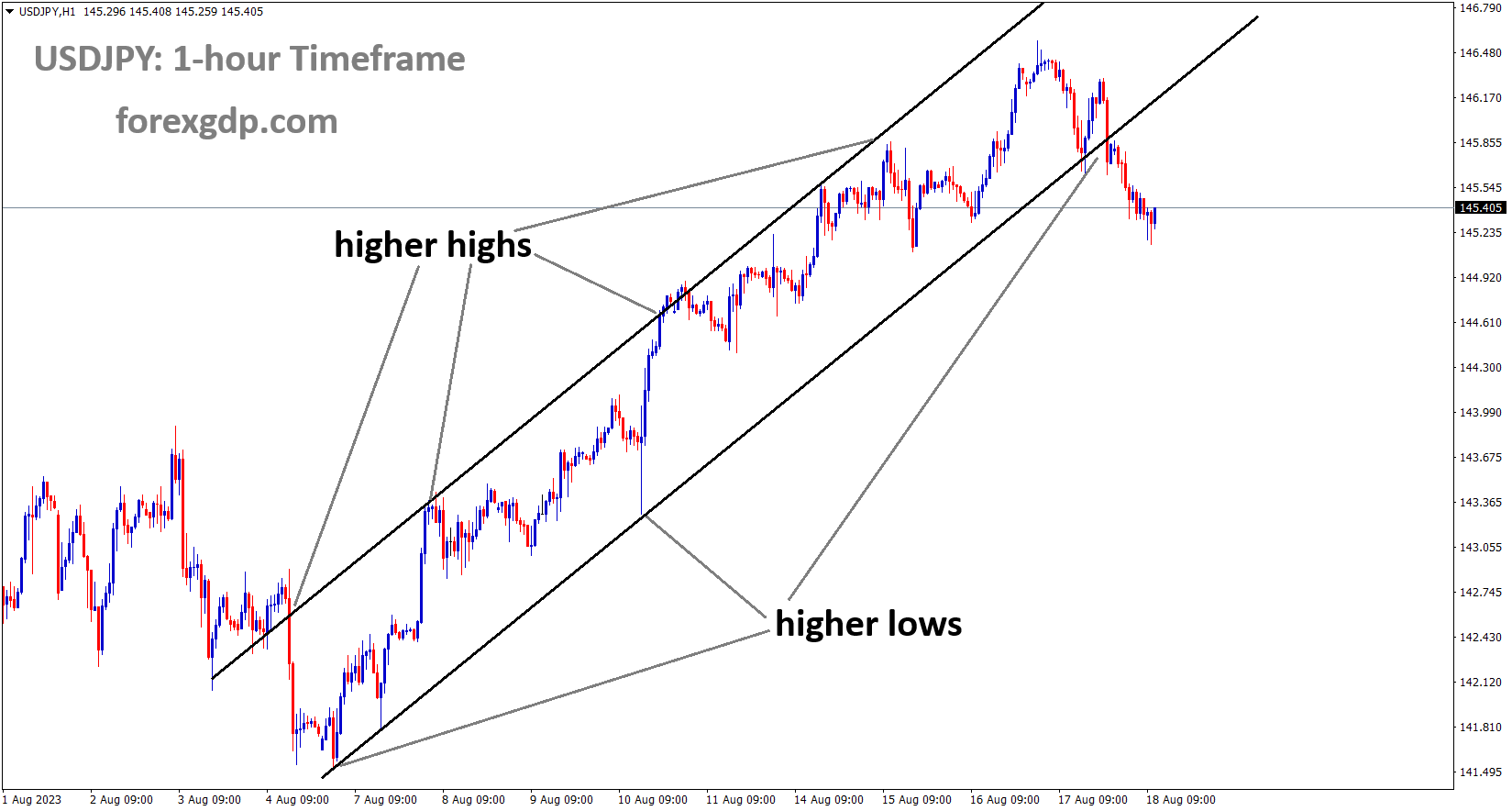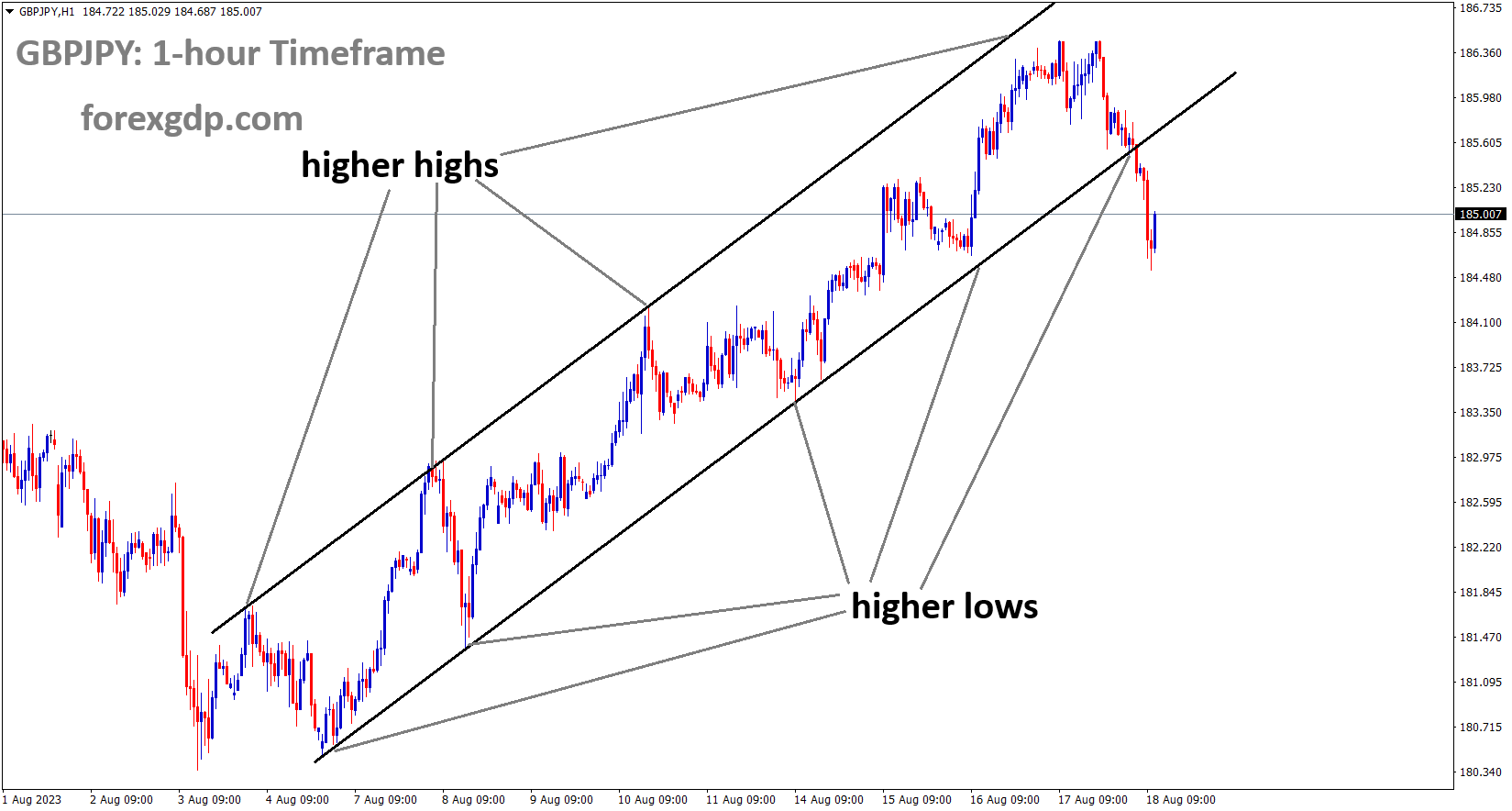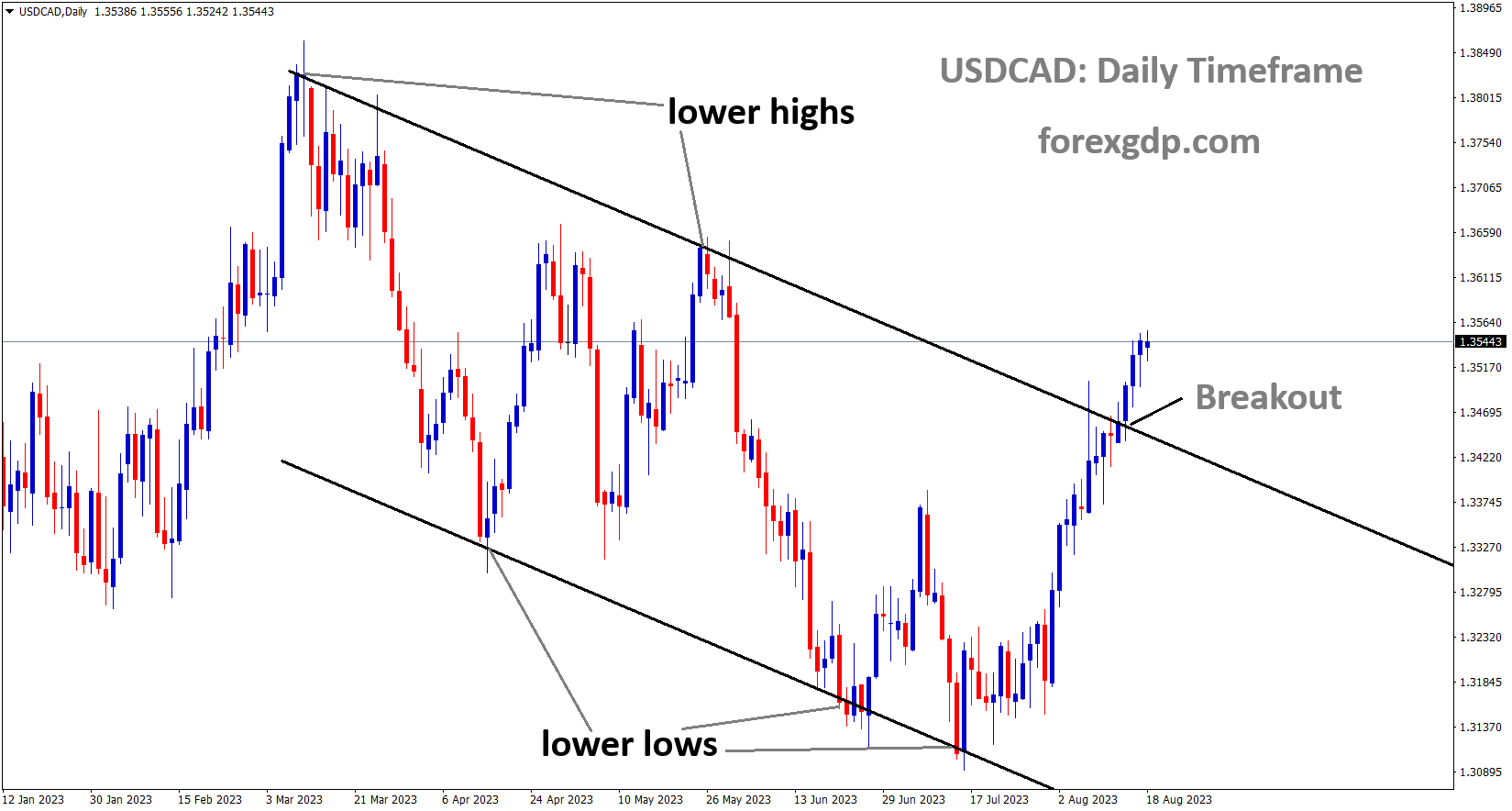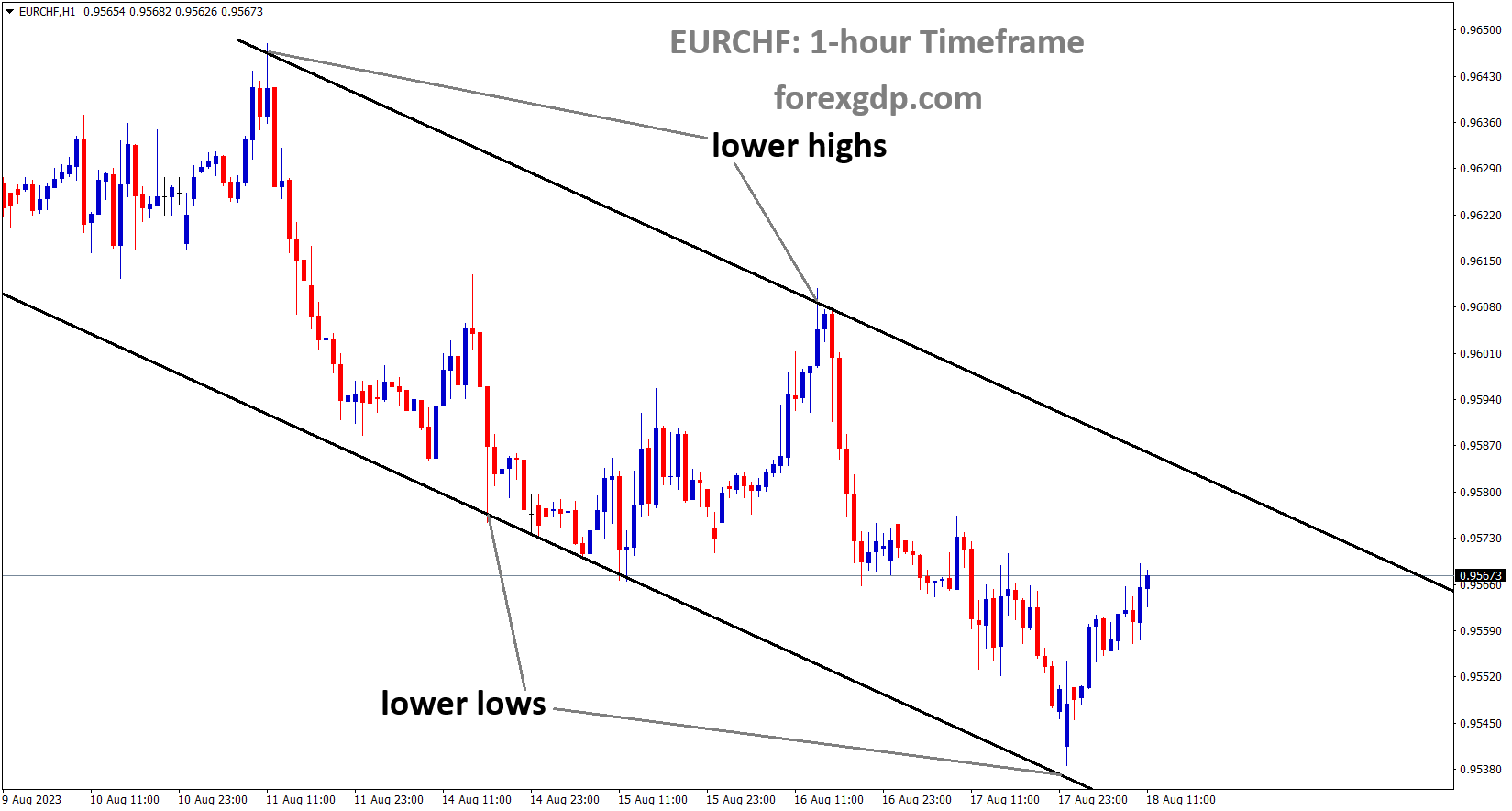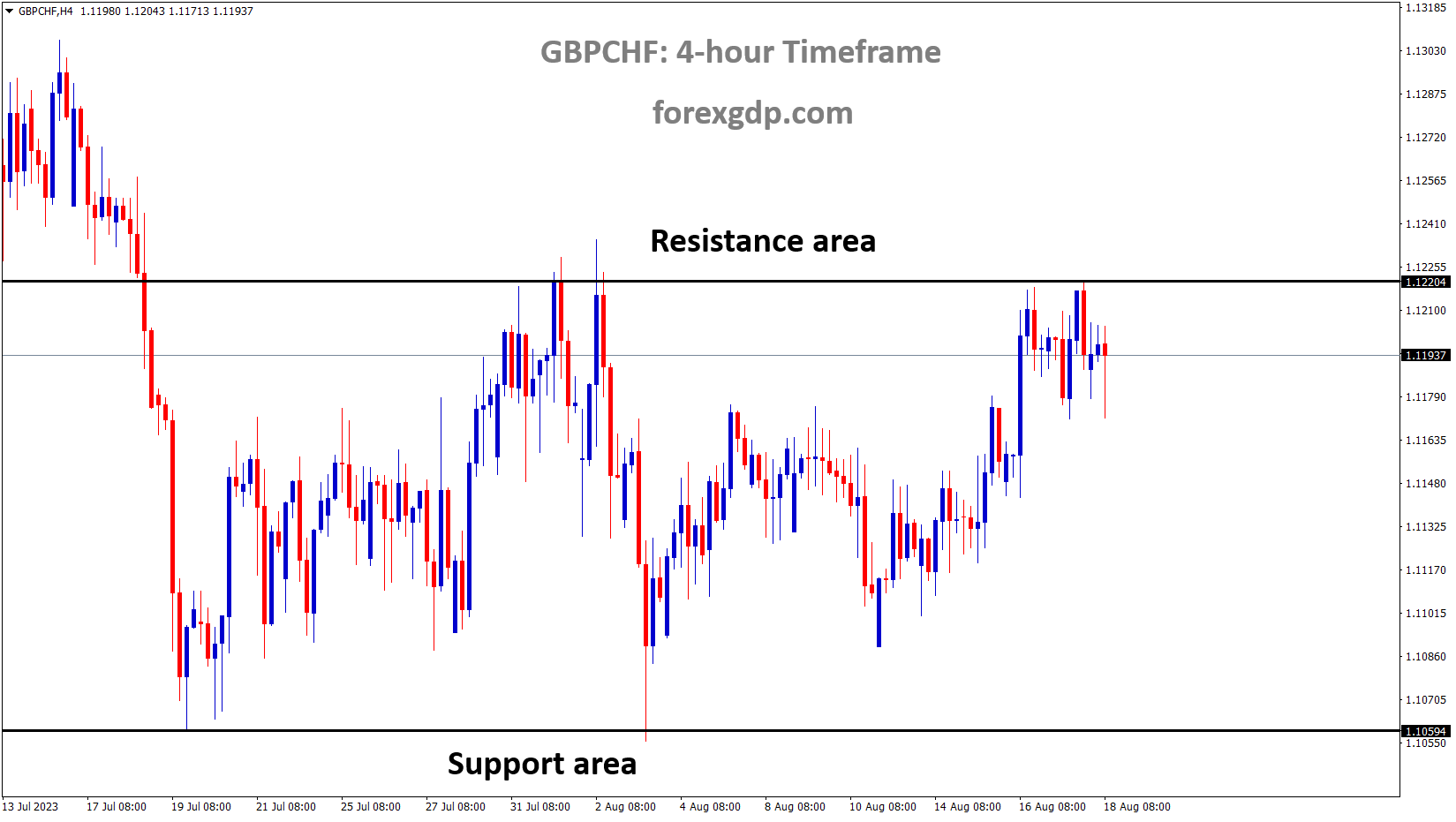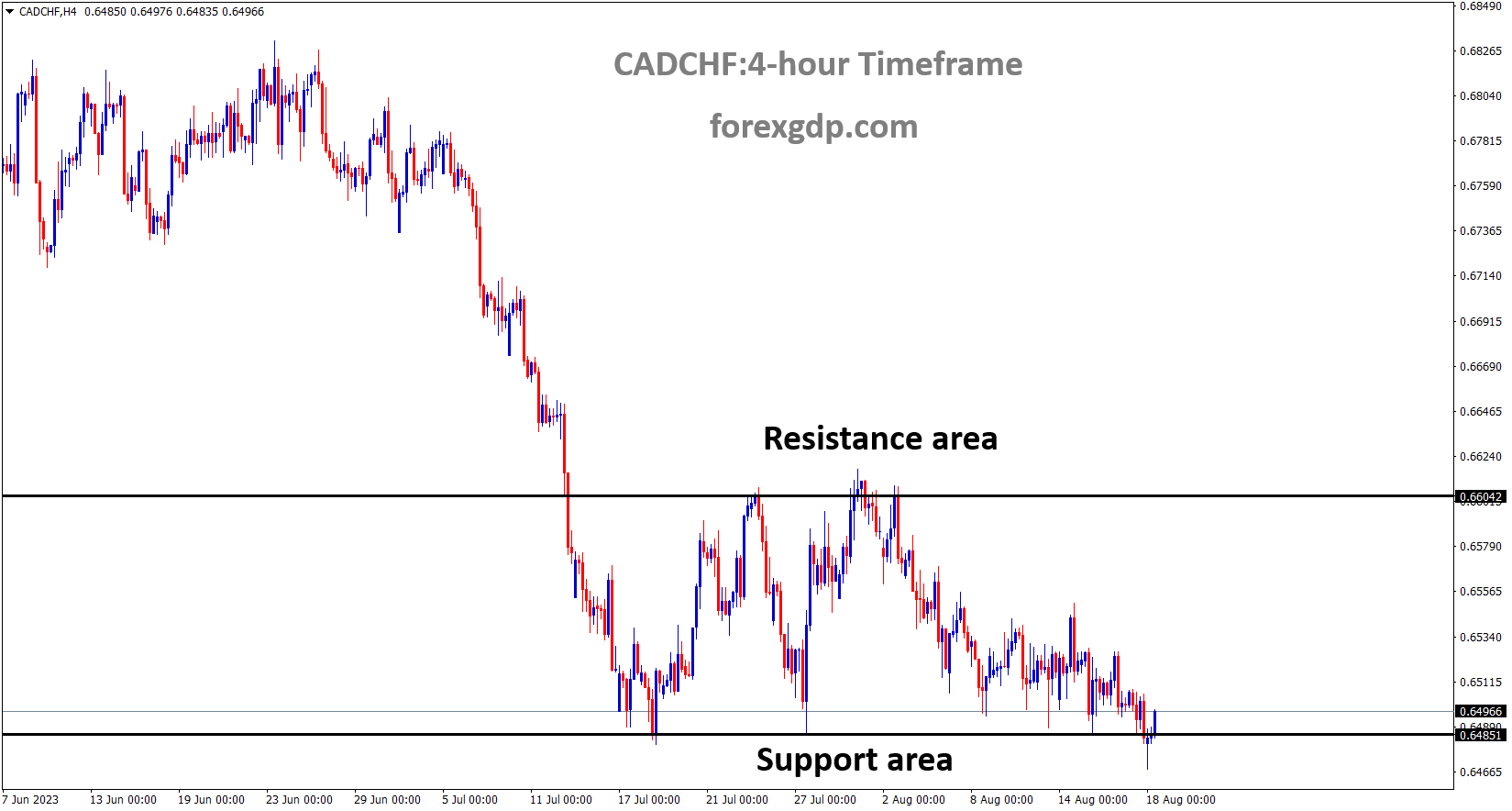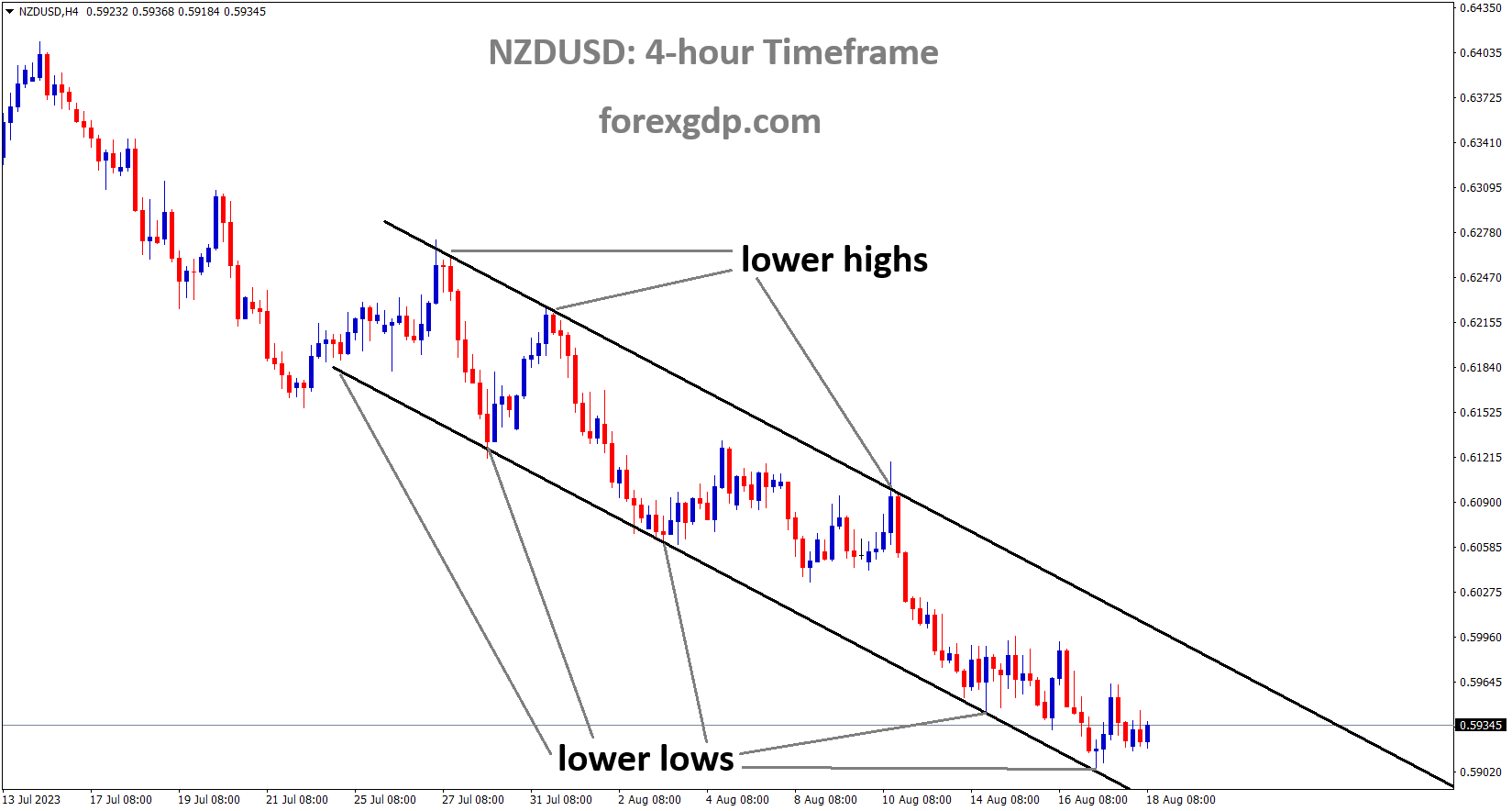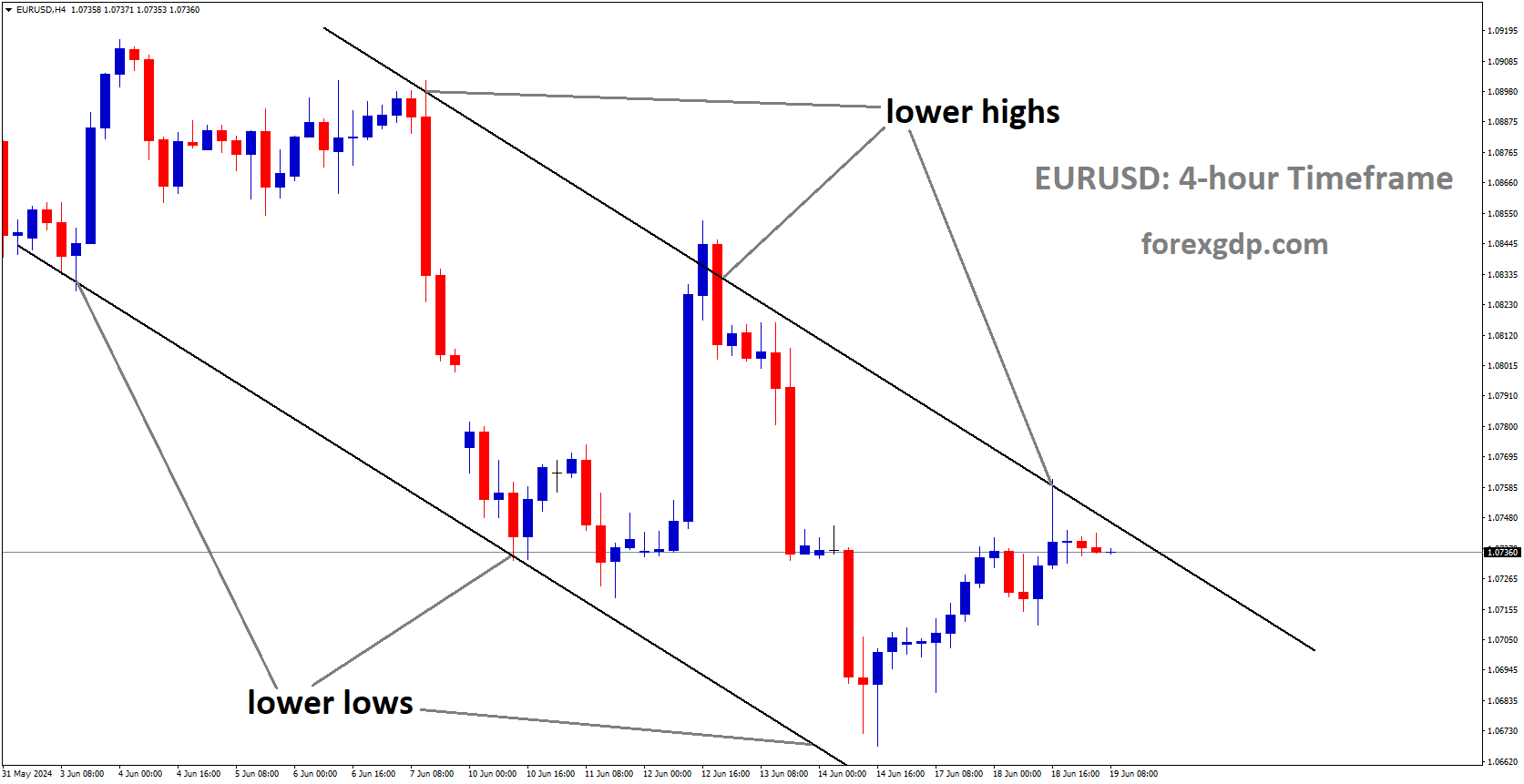AUDUSD Analysis
AUDUSD is moving in the Descending channel and the market has reached the lower high area of the channel
Australia lost 14,600 jobs in July, according to the Australian Bureau of Statistics, and the country’s unemployment rate increased to 3.7%. The RBA is therefore less likely to raise rates at its upcoming meeting.
The AUDUSD pair gains some positive momentum during the Asian session on Friday, building on the overnight bounce from the 0.6365 area, or its lowest level since November 2022. Spot prices have risen over 0.6400 in the last hour, and they appear to have ended an eight-day losing run for the time being, though any significant upward movement remains elusive. As China’s second-largest real estate company, Evergrande, and a related business, Tianji Holdings, filed for protection from creditors in a US bankruptcy court on Thursday, worries about the nation’s heavily indebted real estate market grew. This heightens worries about China’s deteriorating economic situation and feeds speculation about further stimulus packages, which in turn causes some money to flow towards the Australian Dollar AUD, which serves as a stand-in for China. On the other hand, the US Dollar USD is seen accumulating slightly below its highest level since July 12 touched on Thursday, which proves to be another factor supporting the AUDUSD pair.
On the other hand, the USD decline could only be explained by a slight decline in US Treasury bond rates from a multiyear high. Recall that in October 2022, the yield on the benchmark 10-year US government bond surged back towards the highest level since 2008, following a growing consensus that the Federal Reserve will maintain higher interest rates for an extended period of time. The FOMC meeting minutes from July 25–26, which showed that policymakers were still giving the fight against inflation top priority, confirmed the expectations. The USD and US bond yields should benefit from this, eventually capping the AUDUSD pair. In addition, traders may decide against making aggressively bullish bets on the Australian dollar in the wake of growing speculation that the Reserve Bank of Australia (RBA) would decide to keep interest rates on hold again in September, which was reinforced by the dismal domestic jobs data released on Thursday. In actuality, the economy lost a net 14,600 jobs in July, according to the Australian Bureau of Statistics (ABS), and the unemployment rate unexpectedly increased to 3.7%. Therefore, in the absence of any pertinent US economic data, it will be prudent to wait for strong follow-through buying before confirming that the AUDUSD pair has formed a near-term bottom and positioning for any further recovery.
XAUUSD Analysis
XAUUSD Gold price is moving in the Descending channel and the market has rebounded from the lower low area of the channel
Due to rising US Treasury yields and 10-year bond prices, which reached their highest point since 2007, gold prices began to decline.
Prior to Friday’s trading session, the US Dollar is still strong due to rising Treasury yields, which is driving down the price of gold. While spot gold fell to its lowest level since March after hitting US$ 1885 oz, the DXY (USD) index traded at its highest level since early June overnight. The benchmark 10-year bond traded at 4.328% during the North American session due to the spike in Treasury yields. That was only slightly less than the 4.335% return on that note recorded in October of last year, which was the highest since 2007. The decline in the Chinese Yuan might be what pushes the Dollar higher. China was once more selling bonds through June, according to recent data on Treasury holdings. This year, they have sold in every month but March, when the Yuan saw a notable increase. Authorities in the country are facing some difficulties as a result of the massive property developers Country Garden and Sino Ocean’s defaults on multiple onshore and offshore bonds this month. Following several client obligations missed by Zhongrong International Trust Co., a significant player in China’s trust sector, over the course of the last week, there are worries that the situation in the property market may have further repercussions.
XAGUSD Analysis
XAGUSD Silver price is moving in an Ascending channel and the market has reached the higher low area of the channel
Evergrande, a sizable Chinese real estate business, then filed for Chapter 15 protection in the US on Thursday. Filing under Chapter 15 is comparable to filing under Chapter 11, but it is intended for businesses with both US and offshore interests. Previous experience has shown that financial markets become uneasy when the possibility of contagion materialises. In these situations, gold is occasionally viewed as a kind of “haven,” but this most recent market schism has not been the case. Moreover, treasuries are viewed as a risk-free investment and are occasionally sought after during turbulent times. The price of both of these assets has been declining, and the price action may be driven by the developments that are emanating from China. As Treasury yields rise and the capital value declines, investors may decide to steer clear of the yellow metal that yields no yield. An indicator of implied volatility for gold, the GVZ index is computed similarly to how the VIX index interprets volatility for the S&P 500. Although it has been sluggish lately, this gold volatility index is trending upward this week. This could mean that there is growing market trepidation and that a big price shift is about to occur. Authorities in China may need to sell more USD to support the Yuan if the country’s situation worsens. This might result in increased interest in the Dollar across various markets, such as XAU/USD. Click the banner below to find out more about trading gold.
USDJPY Analysis
USDJPY is moving in an Ascending channel and the market has reached the higher low area of the channel
Following the Bank of Japan meeting last month, the 10-year bond yield cap increased, and Japan’s CPI data came in 3.3% higher than the market’s expectations of 2.5%. JPY gained strength versus counter pairs subsequent to the announcement.
Before the early European session on Friday, the USDJPY pair starts to lose momentum below the mid-145.00s. In comparison to its competitors, the Japanese Yen is supported by positive data. Retracing from a Year-To-Date YTD high of 146.56, the major pair is currently trading at 145.18, down 0.45% for the day. The Statistics Bureau of Japan released the July YoY Consumer Price Index CPI data on Friday. The index came in at 3.3%, which was higher than the 2.5% market estimate. In the meantime, the National CPI, which does not include fresh food and energy, grew from 4.2% to 4.3% YoY, in line with market expectations. It is important to note that the Bank of Japan BoJ maintains its extremely loose monetary policy while allowing the yield cap on 10-year bonds to become more flexible. The BoJ and Fed’s differing monetary policies could put pressure on the Japanese yen against its main competitors and act as a drag on the USDJPY pair.
GBPJPY Analysis
GBPJPY is moving in an Ascending channel and the market has reached the higher low area of the channel
However, for the week ending August 12, fewer people filed for unemployment benefits, suggesting that there is still a tight labour market. The US unemployment claims fell to 239K in the week that ended on August 12. Based on data released on Thursday by the US Bureau of Labour Statistics BLS, the number was marginally lower than the 240K market estimate. A total of 1.716 million Continuing Jobless Claims were filed in the meantime. Lastly, the August Philadelphia Federal Reserve Manufacturing Survey improved to 12, surpassing the prior -10 and -12 market consensus. The US data support the Federal Reserve’s Fed argument for another interest rate increase. Wednesday’s FOMC Minutes made clear that inflation is still too high and that more tightening of monetary policy may be needed to bring it down to the desired level. Future prospects for the USDJPY pair are uncertain because neither the US nor Japan have released any economic data, leaving it vulnerable to USD price dynamics. News about China’s debt crisis will likely be closely watched by investors, which could reduce their appetite for risk.
USDCAD Analysis
USDCAD has broken the Descending channel in upside
Recent higher-than-expected CAD CPI data this week indicates that the Bank of Canada will likely tighten monetary policy even more. The US Philly FED Manufacturing index surged to 12 from -10 the previous month, strengthening the USD’s position versus the CAD.
As investors processed the US Federal Reserve’s (Fed) most recent monetary policy meeting minutes, which show board members as dedicated to reaching the Fed’s inflation target, USDCAD surged to new two-month highs on Thursday. All those present voted in favour of an increase in rates, despite the concerns of some board members regarding overtightening. At 1.3546, the USDCAD exchange rate is nearly unchanged. Wall Street ended the day with losses, and the US Dollar Index (DXY), which is trading at 103.437, indicates that the greenback is doing nearly unchanged. Last week, there was an increase in unemployment claims, with 239K recorded, according to data from the US Bureau of Labour Statistics (BLS). This number showed a robust labour market because it was marginally lower than the estimated 240K. Meanwhile, the Philadelphia Fed released its August Manufacturing Index, which came in at 12, above the -10 contraction that analysts had projected.
The minutes of the Federal Reserve’s July meeting were made public on Wednesday. According to minutes, members of the Federal Reserve continue to believe that there is a risk of inflation going up. This implies that additional stringent measures may be required. They did, however, also stress how committed they were to taking into account the data from the upcoming meetings. A number of regional Fed Presidents have stated that rate hikes should stop, including Bostic, Goolsbee, Harker, and Barkin. The Atlanta Fed GDPNow model forecasted a growth rate of roughly 5.8% for the US Q3 2023 GDP following the data release on Wednesday. Compared to the 4.1% estimate made on August 8, this represents an increase. In light of these developments, the swaps market has signalled a higher probability of a 25 basis point increase in interest rates by the Federal Reserve at its upcoming meeting in November. More growth in the USDCAD pair is anticipated given the strength of the US economy. However, the chances of further tightening by the Bank of Canada (BoC) may increase in light of the recent inflation report in Canada.
EURCHF Analysis
EURCHF is moving in the Descending channel and the market has rebounded from the lower low area of the channel
The June trade surplus data for the Eurozone has improved, and the June industrial production figures have increased. The GDP figures for the Eurozone were as expected, and July’s employment change was lower than expected.
The Eurozone and Germany’s economic slowdown. The both seasonally adjusted s.a. and non-seasonally adjusted n.s.a. data for June showed improvements in the Eurozone trade surplus. That being said, the priors were €0.2B and €-0.3B, respectively, and the former increased to €12.5B while the latter increased to €23B. The second readings of the Eurozone Gross Domestic Product GDP for the second quarter Q2 confirmed preliminary estimates, while the Employment Change decreased for the same period. Earlier in the week, the Eurozone Industrial Production showed a surprising increase for June. It is important to note that the market’s cautious attitude ahead of next week’s annual Jackson Hole Symposium, where leading central bankers will be speaking. Looking ahead, it will be important to watch the final Eurozone inflation readings for July and Philip Lane’s speech as Chief Economist of the European Central Bank ECB.
GBPCHF Analysis
GBPCHF is moving in the Box pattern and the market has fallen from the resistance area of the pattern
The expectation of further rate hikes by the Bank of England in the upcoming months has caused the 10-year and 2-year gilt funds in the UK to soar in value. The higher yield for investors in fixed income debt is the reason why GBP is surging against counter pairs.
The yield on UK government debt is rising due to the pressure from fixed-income traders, which is driving up the value of the British Pound against the strong US dollar. The yield on the benchmark UK 10-year is almost back to levels reached almost 15 years ago, while the rate-sensitive UK 2-year is currently trading at a one-month high yield of 5.25%. Expectations that the Bank of England BoE will keep raising borrowing costs in an effort to drive exceptionally high inflation back down to the central bank’s target have led to a push higher in yields on UK government bonds. Although the FOMC minutes released on Wednesday suggested that most Fed members continued to see significant upside risks to inflation which could require further tightening of monetary policy, the GBP/USD pair has strengthened. This cautious assessment is in line with recent remarks from the Fed indicating that additional effort is needed to combat US inflation. Fed Chair Jerome Powell will have the ideal opportunity to remind markets that the central bank can and will raise rates further if necessary during next week’s Jackson Hole Symposium August 24-26.
CADCHF Analysis
CADCHF is moving in the Box pattern and the market has reached the horizontal support area of the pattern
In advance of the Q2 2023 Swiss Industrial production, the Swiss Franc appreciated versus counter pairs today.
The weak market movements in anticipation of the mid-ties Swiss data and the annual Jackson Hole Symposium next week, where leading central bankers will be speaking, are tracked by the Swiss Franc (CHF) pair. Furthermore, according to Reuters, Evergrande, the second-largest real estate company in China and the most indebted property developer globally, filed for protection from creditors in a US bankruptcy court on Thursday, escalating market concerns. The same exacerbates problems with the second-biggest economy in the world and the global economic shift as it struggles with the sluggish pace of economic recovery and feeds worries about the financial stability of Country Garden, China’s largest real estate company. Nonetheless, it appears that the pessimists have been challenged by worries about how willing Chinese policymakers are to provide additional stimulus to protect the economy from debt problems. Swiss Industrial Production is expected to grow by 3.4% YoY in the second quarter of 2023.
NZDUSD Analysis
NZDUSD is moving in the Descending channel and the market has reached the lower low area of the channel
Assistant Governor Karen Silk of RBNZ stated that the slowdown in China’s and other countries’ economies causes the New Zealand economy to contract because exports of dairy and meat tend to decline and prices will skyrocket in 2024.
The Reserve Bank of New Zealand’s (RBNZ) Assistant Governor Karen Silk stated in a Friday interview with Reuters that the rate forecast is at risk due to the slowdown in China and the weak global economy. It was “definitely reasons to be concerned” that China’s economy was fragile. Indeed, there are undoubtedly certain difficulties in China. Since it is our biggest trading partner, we naturally have concerns about it. The downside risk that we see through the medium term is the pressures that we are starting to see offshore around that global growth. The bank maintained its forecast that dairy prices would rise in 2024, but acknowledged that the economy was at risk due to China’s declining demand for dairy products as well as other commodities like meat and forestry.
Don’t trade all the time, trade forex only at the confirmed trade setups.
Get Live Free Signals now: forexgdp.com/forex-signals/

